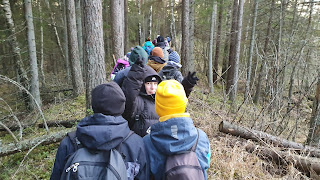Aga nüüd asja juurde.
Esimese klassi huvitavad toimetused - jagab õpetaja Pille:
Tervisliku toitumise teemat alustasime värvi loosi võtmisega. Loosilipilku värv oli kaasavõetava puu-või köögivilja soovituslikuks värviks. Kaasatoodud puu-ja köögiviljad jaotasime kõigepealt värvi järgi. Seejärel uurisime viljade välimust ning arutlesime selle üle, et milliseid vilju veel värve arvestades teati ja osati nimetada.
Seejärel tükeldasime viljad. Iga laps püüdis oma taldrikule teha oma tervise vikerkaare, valides meelepärased viljad. Huvitav oli kogeda uusi maitseid.
Seejärel sai iga õpilane erinevaid vilju kujutava värvimiseks mõeldud pildilehe. Kui viljad värvitud, sai need välja lõigata ja ühistööna vikerkaareks kleepida.
Ja teise klassi õpetaja Kristel viis läbi sellise projektipäeva:
2.klass keskendus projektipäeval tervislikule toidule. Lapsed olid kaasa võtnud omal valikul ühe köögi- ja puuvilja. Rühmades ennustasid nad viljade kaalu ja pikkust ning võrdlesid siis kaaludes ja mõõtes tegeliku tulemusega. Rääkisime viie vilja vikerkaarest ja maitsesime erinevaid vilju. Ja siis algas päeva kõige oodatum osa, milleks oli pannkookide valmistamine. Taigen valmis kolmes grupis mahe toor-tatrajahust. Moosi asemel tegid lapsed püreed: ühe metsmustika-banaani ja teise maasika-banaani. Ühe panni ümber askeldamine nõudis head koostööd ja üksteisega arvestamist. Pannkoogid olid imemaitsvad ja nii mõnegi arvates parimad, mida ta iial söönud on. Ise tehtud, hästi tehtud:)
Healthy food lessons
First grade food rainbow lesson shared by teacher Pille:
Then we cut the fruits. Each child tried to make a rainbow of food on their plate, choosing the fruit they wanted. It was interesting to experience new flavors.
Each student then received a picture page for coloring different fruits. Once the fruits were coloured, they could be cut out and glued together as a rainbow.
And second-grade teacher Kristel ran a project day like this:
Grade 2 focused on healthy food on the project day. The children had brought with them a choice of vegetables and fruits. In the groups, they predicted the weight and height of the fruit and then compared it to the actual result by weighing and measuring. We talked about the rainbow of five fruits and tasted different fruits. And then the most anticipated part of the day began, which was making pancakes. The dough was prepared in three groups of organic raw buckwheat flour. Instead of jam, the children made purees: one wild blueberry and another strawberry banana. Fussing around one pan required good cooperation and respect for one another. The pancakes were delicious, and by some, the best they had ever eaten. Self made, well done :)


























